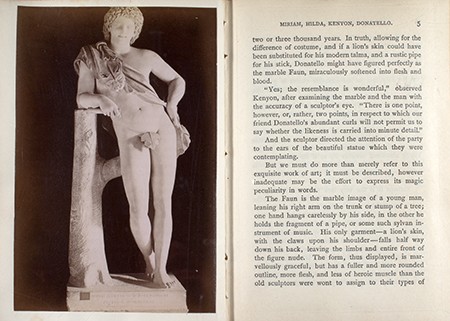In the late nineteenth century regular and affordable steamships and railways carried Americans to and around Europe in growing numbers. Many of these travelers were aspiring women artists seeking the training and contact with original works of art that they could not receive at home. They naturally gravitated to Rome, where Henry James evocatively but dismissively characterized some of them as a “strange sisterhood of American ‘lady sculptors’ who at one time settled upon the seven hills in a white, marmorean flock.”
The poet and sculptor Anne Whitney (1821–1915) was part of this group. She and her companion, the painter Addy Manning (1836–1906), lived abroad in 1867–1871 and 1875–1876, primarily in Rome, but also in Florence and for several months each summer in more temperate locales. Their lives abroad, as revealed in the art and other objects they created, admired, and acquired, and in the more than three hundred letters they wrote to and received from family and friends, form the framework for my study. My research also examines contemporary newspapers as well as the letters and diaries of other sculptors, painters, authors, patrons, and travelers, both female and male, held in archives and institutions here and abroad. While in residence at CASVA I spent much of my time examining unpublished documents at the Library of Congress and the Archives of American Art. These primary sources demonstrate that Whitney’s experience abroad was not unique, though her detailed documentation of it was extremely unusual, and they provide me with a way to construct a vivid narrative of the experience of American women artists in Italy.
Whitney and her peers realized they were doing something new, but they had few models to guide them. Perhaps the most notable was Margaret Fuller, author of Woman in the Nineteenth Century (1845) and the first female foreign correspondent for the New York Tribune. After Fuller’s death in 1850, her brother compiled her writing in a volume entitled At Home and Abroad (1856). I altered the title of that volume for my book to reflect the manner in which Whitney and her sister artists made Italy their home for both short and long periods of time. At the same time, however, this was a fraught period in Italian history. The tensions of unification, which pitted the papacy against the secular government to create the modern state, resulted in political, economic, and social upheavals across the peninsula.
Despite these tensions, American women appreciated what Italy offered them. They were informed by works such as Germaine de Staël’s Corinne (1807), Elizabeth Barrett Browning’s Aurora Leigh (1857), and Louisa May Alcott’s Little Women (1868), all of which celebrated Italy as a destination for independent, creative women. The character of Amy in Little Women, like Alcott’s real painter sister May, confirmed this; she stated that she wanted to “go to Rome, and do fine pictures, and be the best artist in the whole world.” Nathaniel Hawthorne’s The Marble Faun (1860), a novel about the Rome Hawthorne knew from his own visit in the late 1850s, revolved around three American artists — the male sculptor Kenyon and the female painters Hilda and Miriam—and the ways in which the women circumvented social norms and were integrated (or not) into Roman culture. Hawthorne’s vivid descriptions of sites and works of art made the novel necessary reading for all travelers or would-be travelers. An especially popular edition, published by the Leipzig firm Tauchnitz, was sold by English-language booksellers throughout Europe. Each volume came with blank pages onto which the purchaser could paste specially purchased photographs, after which it was professionally bound to create a personal souvenir. The copy in the image collections of the National Gallery of Art Library, in two volumes with cream vellum bindings and decorative endpapers, has forty albumen prints of photographs—including one of the titular faun (sometimes known as Resting Satyr), inserted in the first chapter at the point where Hawthorne’s artists admire it in Rome’s Capitoline Museum.
My book examines how Italy transformed American women artists—whether real, like Whitney and Manning, or fictional, like Hilda and Miriam—and how they brought their experience home. I look at what these women made, saw, wrote, bought, sold, and lived with while abroad as well as on their return to the United States. They were the first American women to live independently in Italy and learn from its art and history. Their lives abroad gave them a perspective they would not have had otherwise, and their experiences make them much more interesting than the anonymous flock described by Henry James.
